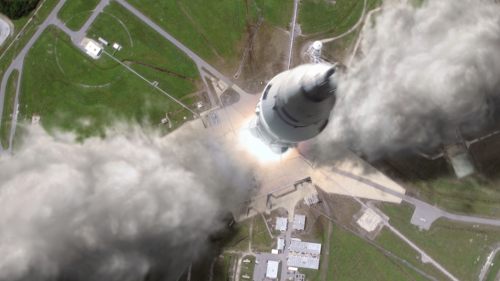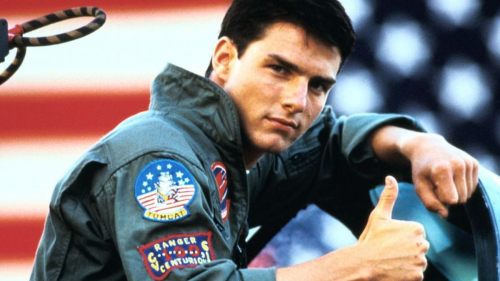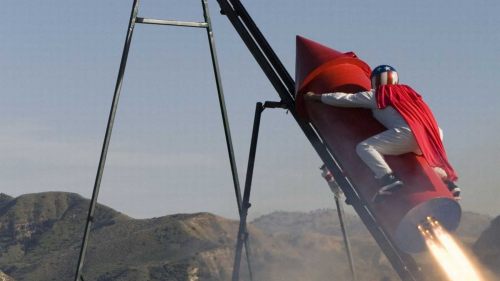The Impossible Toolbox: Tracing Technology Across the MISSION: IMPOSSIBLE Series
Mission: Impossible - Fallout comes out tonight. Get your tickets here!
The Mission: Impossible film series is over 20 years old. One of the pleasures of a project that’s lived that long and been worked on by such a wide range of people is how mutable it is. Brian De Palma made a paranoia picture that repeatedly toyed with its audience. John Woo made a melodramatic bullet opera that doubled (heh) as a pseudo-Hitchcock remake. J.J. Abrams’ Mission: Impossible III is a post 9/11 paramilitary actioner fueled by both global and personal anxieties. Brad Bird’s Ghost Protocol is a modernized take on the original tv series’ ensemble focus and its everyone’s-got-a-part-to-play espionage tales. Christopher McQuarrie’s Rogue Nation explores the struggle to do right in a disjointed, disconnected world while blending MI:2, III and Ghost Protocol’s assorted approaches to action into an impressively coherent whole.
Every Mission: Impossible movie feels distinct from its siblings. Simultaneously, they’ve got a lot in common. Most famously, each movie showcases practical stunt work that is never less than impressive (the first film’s iconic hanging infiltration of the CIA’s computer vault at Langley) and has more than once been genuinely astonishing (the free-climb that re-introduces Tom Cruise’s Ethan Hunt in MI:2 or better still his daring ascent of the Burj Khalifa in Ghost Protocol). Less dramatic but equally key to the series’ success is its recurring theme. The Mission: Impossible pictures each have their own storytelling styles and interests, but every last one of them has, in one way or another, explored the places where technology, spycraft and humanity meet. It’s not as immediate or dramatic a pleasure as watching Tom Cruise descend high places at top speeds without dying, but it’s a very satisfying one.
Mission: Impossible is a Brian De Palma picture through and through. Working for the IMF apparently requires a deep knowledge of international cinema. And while it may lack the buckets of blood found in Carrie and Scarface, several folks die horrific, ironic deaths. Chief among them is poor Emilio Estevez, the communications expert who gets impaled through the eye. De Palma’s long-time fascination with perception and voyeurism is woven throughout Mission: Impossible. Rogue agent Jim Phelps (John Voight) wipes out his team by futzing with their tech and sowing confusion. This culminates in his faking his own death over video, apparently gunned down by an anonymous assassin. Ethan Hunt has to watch and listen to his team die. Phelps’ plan turns on everyone believing what he shows them, on their trusting both his character and the reliability of their methodology. Prior to Phelps wiping Ethan’s team out, they’re established as skilled spies who know their craft and their tools inside and out. But they never expected that someone would turn their tech against them. The spy cameras that show them everything they need to see become tools of obfuscation. When Ethan realizes Phelps’ deception, he doesn’t just see why Phelps turned heel, he sees how it was done. Gadgets are great, but they’re only as trustworthy as the people using them. And when you can’t trust the person, you can’t trust the gadget.
MI:2 features multiple characters too caught up in themselves to realize or remember the implications of their tech until far too late. Dr. Nekhorvich (Rade Šerbedžija) sought a universal flu cure, Bellerophon. In the process, he created Chimera, a supervirus. Biocyte, his employers, saw an opportunity – start a plague, sell the only cure for whatever they want and spend the rest of their days swimming in cash. Desperate to prevent this, Nekhorvich turned to the IMF. With Ethan on vacation, they employed one of their famous masks on Dougray Scott’s Sean Ambrose, an agent who had doubled for Ethan before. Unfortunately for the IMF, the egomaniacal Ambrose was tired of being an anonymous ringer. He murdered Nekhorvich, swiped Bellerophon and set out to enact Biocyte’s plan on his own terms. But for all his cunning, Ambrose is a narcissist who barely lives in the real world. He sees Chimera as a means to an end, not a potentially civilization-killing pathogen. He’s genuinely shocked when old flame turned foe Nyah (Thandie Newton) chooses to destroy the last sample of the virus by infecting herself rather than potentially kickstart the apocalypse. And during MI:2’s climax, he forgets that Ethan, his shadow self, has access to the same technology he does. When his chief goon Stamp (Richard Roxburgh) presents him with a captured, helpless Ethan, Ambrose forgets the rest of the world. He sadistically tortures and murders his hated foe with utter glee. In reality, Ambrose has just killed his own right-hand man while Ethan almost literally walked out the back door with the key to his schemes, courtesy of the same masks Ambrose himself had earlier used to similarly devastating effect. Tech in MI:2 does not adhere to personal codes or personal grudges. It does what it’s designed to do. Losing sight of that fact is a very, very bad idea.
Where Nekhorvich and Ambrose missed the full implications of what their tech could do until it was too late, Mission: Impossible III’s terrifying Owen Davian (the late and much-missed Philip Seymour Hoffman) prefers to keep things simple. He doesn’t need a superflu or an IMF mask. He just needs a small bomb in the right place at the right time. Detonate the bomb, cause an explosion, end a life, unleash suffering. Davian’s fellow villain Musgrave (Billy Crudup) operates on the same methodology. Make sure that Davian gets his hands on an incredibly dangerous piece of whatsit known only as the Rabbit’s Foot, then use the fact that a powerful arms dealer has the lethal something-or-other to lead IMF into war. Davian and Musgrave are effective with their tech because they know precisely what it does and precisely how to use it. Conversely, once Ethan knows Davian’s MO, he’s able to successfully disarm the bomb planted in his own skull. He too knows the what and the hows that come with tech, but he uses it to positive ends.
Ghost Protocol’s tech is a bit of an odd duck compared to the gear featured in its sister films, mostly because very little of it actually works all that well. An IMF agent’s facial recognition tech warns him of Sabine, an approaching assassin (Léa Seydoux), thereby distracting him enough for her to effortlessly kill him. Ethan has to repeatedly bang on the phone containing the series’ famous self-destructing message to trigger its detonator. When he and his team set out to pull a fast one on the assassin and the fanatical, nuclear-war-seeking ex-nuclear strategist Hendricks (the late Michael Nyqvist), their mask machine breaks, and one of the magnetic climbing gloves Ethan uses to scale the Burj malfunctions to the point that he ditches it (only to re-encounter it later in his ascent). Even the nuclear football Ethan and Hendricks fight over in the climax doesn’t successfully transmit its abort code to the missile on the first try, hilariously deflating Ethan’s triumphant cry of “MISSION ACCOMPLISHED!” The tech that does work relies first and foremost on human ingenuity (chiefly a magnetized rover and suit that allows Jeremy Renner’s Brandt to safely traverse an otherwise-lethal fan corridor). Ethan’s team gets farther by improvising with what they’ve got at the moment than by simply relying on the tech to do what it’s meant to. Indeed, this proves to be Hendricks’ ultimate undoing. He successfully gets a nuclear missile launched, but he has to use a very specific set of tools to do so. Thus, he has to spend the climax fleeing from Ethan, since there’s no way for him to disable the nuclear football’s failsafe. Tech in Ghost Protocol is tremendously useful, even lifesaving (the one glove that does work), but it’s the people who use it and their ability to see beyond its limitations that win the day.
Finally, there’s Rogue Nation, where the intersections between humanity and technology are arguably at their blurriest. Ethan isn’t running around with a robot arm, but he and his team are up against a particularly dangerous, particularly flexible piece of technology – an idea. The Syndicate, a private army of ruthless ex-spies who seek to destabilize the world for fun and profit, began as an ill-conceived MI-6 operation – create a hybrid paramilitary/intelligence agency whose existence was known only to a tiny number of people, allowing for the unilateral imposition of British geopolitical power with neither oversight nor consequence. The scheme was ripe for corruption, and sociopathic spy Solomon Lane (Sean Harris) jumped at the opportunity to hurt as many people as possible under the guise of making his superiors pay for their arrogance in conceiving of the Syndicate. He built the Syndicate into a thriving criminal operation, and his goal in Rogue Nation is to acquire the monetary resources he needs to grow it from an organization into a full-fledged independent geopolitical power. This proves to be a critical weakness – as dangerous as the Syndicate is, as successful as its operations have been so far, Lane and his cohort cannot throw the world into total chaos fast enough to keep it from recovering. They need real, concrete resources to sustain their operation beyond the day to day. When Ethan memorizes the contents of the hard drive containing those resources and then destroys it he, in effect, becomes the drive. Without him alive, the Syndicate will fail. With him alive, they have to deal with a dangerous, cunning enemy who has vowed to destroy them and who has the means to do so. Corrupting the concept of the Syndicate was one thing. Achieving it was another one entirely. Without concrete tools to make that happen, Lane’s plans, while exceptionally dangerous, ultimately proved ethereal. When the IMF captures him at Rogue Nation’s close, they essentially kill the Syndicate right then and there. Without Lane, it’s nothing more than a concept – a group of mercenaries with a name and a vague, unfulfillable notion.
It’ll be rather exciting to see how Fallout picks up the series' fascination with tech and where it’ll run with it.
This article is part of B.M.D. Guide To: MISSION: IMPOSSIBLE



